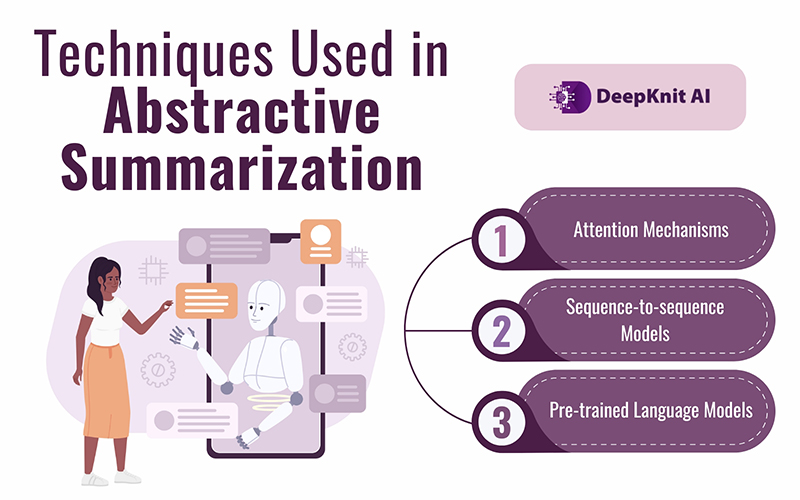Your watch says 9.00 am. You just arrived at the office. There’s a board meeting at 10.00 am, and you have a 40-page PDF of the annual report on your desktop screen.
What are the key takeaways from the report? What are the pain points to address? You hardly have time to go through it all and prepare notes for the meeting. Many C-suite employees have faced this situation.
This is where AI summarization tools come in handy. They can parse the entire document and give you a summary in a couple of pages with all the important details, and all this in a few seconds. But can the output be trusted to be free of factual or contextual errors?
The simple answer is ‘Yes’, but how does the software accomplish this?
To begin with, AI document summarization is the application of artificial intelligence (AI), specifically Natural Language Processing (NLP), to automatically condense large volumes of text into short, digestible, and accurate summaries.
AI summarization tools don’t just pick the first few sentences, a few from the conclusion, and random lines from here and there to present as a summary. The process involves smartly capturing the core arguments, key findings, and critical data points, and presenting them in a coherent narrative.
In this post, we shall explore in detail how this process works.
AI Document Summarization Explained
In the AI document summarization process, there are two primary approaches:
- Extractive Summarization: With its NLP and deep learning capabilities, AI identifies and pulls up the most important lines directly from the original document and stitches them together to form a logical summary. This process is akin to using a marker pen to highlight the most critical parts of a document.
- Abstractive Summarization: This method brings out the true potential of AI. The software reads and comprehends the original text and then generates a summary with new sentences on its own to articulate the main ideas, much like a human would. This produces more fluid and natural-sounding summaries.
How AI Detects the ‘Important Things’ within a Document
The engine behind this seemingly magical process is the sophisticated machine learning algorithms of AI. Even before deployment into your workflows, document summarization AI tools are trained on massive datasets of documents and their corresponding human-written summaries. This intensive training equips the algorithm to recognize the intricate patterns and nuances of human language.
It learns to identify ‘important things’ such as:
- Keyword Frequency: Detects how often certain terms are used in a document.
- Sentence Position: Detects information in introductions and conclusions.
- Semantic Context: Understands the underlying meaning of the content by comprehending the relationship between words and concepts.
The accuracy of AI document summarization has improved with modern systems powered by Large Language Models (LLMs) that comprehend context, causality, and intent with improved precision. They don’t just look at words, they understand the ideas being conveyed. The AI dissects sentence structure and semantic links and creates a map of the document’s most vital information. This enables the software to compose a concise summary without losing contextual relevance.
Now, let’s take a deeper dive into the workings of extractive and abstractive summarizations.
How Extractive Summarization Works?
As mentioned, extractive summarization identifies and separates primary sentences or phrases in the original source text, stitching them together to create concise summaries. The main purpose of the extractive technique is to preserve the integrity of the sentences in the original document.
This method employs statistical algorithms and linguistic analysis to gauge the importance of each textual element by assessing keyword occurrence, word frequency, and sentence position (introduction and conclusion).
The main advantage of extractive summarization is its simplicity and computational efficiency. The process is straightforward, and there is minimal probability of factual errors as sentences from the original text are reproduced verbatim. Nevertheless, the summaries may lack a personal touch and holistic context, though factual information remains intact.
Extractive summarization is preferred for handling sensitive and factual documents like legal reports, contract drafts, and others.
Techniques Used in Extractive Summarization
- Statistical Approaches: These methods evaluate the importance of sentence structures within a document using mathematical models. Algorithms like Term Frequency-Inverse Document Frequency (TF-IDF) and Latent Semantic Analysis (LSA) assess how relevant a word is. While TF-IDF measures a word’s importance based on distribution, LSA uses singular value decomposition to identify hidden themes, reducing dimensionality and noise while maintaining the essence of the text.
- Machine Learning Algorithms: The system trains on models and examples, mapping patterns in data. Features like word frequency, sentence length, and sentence position help identify important sentences using supervised learning models trained on labeled datasets.
- Graph-based Methods: Sentences are represented as nodes in a graph connected by similarity. Algorithms like TextRank and LexRank determine the weight of each sentence, selecting high-scoring sentences for the summary.
- Sentence Scoring: Each sentence is scored based on criteria like position, keyword importance, word frequency, and similarity to other sentences. Sentences with higher scores are included in the summary.
How Abstractive Summarization Works
Unlike Extractive Summarization, Abstractive Summarization doesn’t reproduce sentences verbatim but generates human-like summaries with a personal touch. It understands the original document and creates new sentences to relay the information to the reader.
Abstractive summarization relies on advanced NLP technologies, such as semantic representation, language modeling, and neural network architectures. These allow it to grasp context and generate shorter, meaningful summaries.
This method is preferred for documents like literary reviews, customer feedback, and similar content. With evolving LLM models, abstractive summarization is becoming increasingly accurate and capable of generating cohesive, natural-sounding summaries.
Techniques Used in Abstractive Summarization
- Attention Mechanisms: Help the model focus on different parts of the source dynamically while generating the summary, improving coherence and relevance.
- Sequence-to-sequence Models: Deep learning models like LSTM networks and Transformer-based models such as BERT and GPT transform input text into summarized output sequences.
- Pre-trained Language Models: Models like BERT and GPT can be fine-tuned for specific summarization tasks. They leverage vast pre-existing text data to produce contextually enriched, human-like summaries.
Hybrid Summarization Techniques
Most modern AI summarization tools use both extractive and abstractive methods for better results. They first leverage extractive techniques to capture all relevant details, then use abstractive models to rephrase and generate concise, fluent summaries.
Pre- and Post- processing Steps
Though AI tools can create useful summaries, the output is only as good as the input document. Pre-processing your document before feeding it into a summarization tool is essential.
Steps for pre-processing include:
- Format Cleaning: Remove distracting elements like page numbers, headers, footers, and line breaks.
- Structural Adjustments: Well-organized documents with clear paragraphs, headings, and subheadings are easier for AI to parse.
- Ensure Clarity: Clear, unambiguous content produces better summaries. Avoid vague details or excessive jargon.
Do not accept the summary blindly—use a human-in-the-loop summarization approach. Think of AI-generated summaries as intelligent first drafts, not the final product. Your critical analysis is essential.
Post-processing steps include:
- Fact-check Key Details: Verify dates, statistics, and names.
- Check Tone and Context: Ensure tonal consistency and add any crucial context that AI may have missed.
- Condense for Clarity: Edit and refine the AI output according to your expertise.
Best Practices for Summarizing Long Texts with AI
- Understand word-limit: Split text exceeding the model’s word limit or use multi-level summarization.
- Be aware of document sources and types: Integrate and organize multiple sources carefully.
- Be informed about model specialization: Use fine-tuned models suitable for your content domain.
- Use multi-level summarization for large documents: Start with high-level summaries, then progressively summarize subsections or chapters.
- Summarize text by topics: Guide LLMs with clear prompts to summarize specific topics instead of the entire text.
Conclusion
As information continues to bombard us daily, summarization has become a vital tool for filtering large volumes into concise, meaningful content. It plays a pivotal role across domains, offering numerous advantages. By leveraging extractive, abstractive, or hybrid summarization using statistical, rule-based, machine learning and deep learning methods, summaries can be created efficiently and accurately. Advancements in AI and ML promise further improvements in text summarization, enhancing context comprehension and precision.
Currently, summarization saves businesses valuable time by converting lengthy documents into concise content that supports quick, informed decision-making. By extracting critical information and improving comprehension, these tools are also beneficial in academics and content curation.
If you wish to deploy a smart document summarization system into your workflow, DeepKnit AI, with extensive experience in helping enterprises realize their digital goals, can guide you through the process.
Make Smart Decisions with Smart Summaries.
Smart Documents to Smart Summaries
Consult DeepKnit AI





